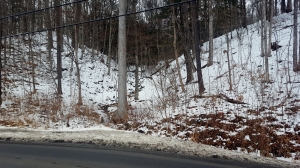A “youthful” stream?
The Catskill Geologists
The mountain Eagle
Robert and Johanna Titus
Feb. 16, 2018
We have been trying to find “winter” topics to write about lately; after all, it is that awful season of snow and ice. This is not a geologist’s favorite time of the year and for good reason. We enjoy getting out during the warm months. We can do so many more things then. But actually, there are things that a geologist can do best in the winter, things that just don’t work out in the summer. Mainly, we can see features that we can’t in the summer. During those warm months all the foliage is decked out. Leaves are pretty; leaves are nice, but they get in the way of seeing the landscape.
Well, that is just not the case in the winter. Take a look at our photo; it shows a very small valley lying alongside a road. In the summer you can go there and hardly see the valley at all. It is small and all the leaves obscure the view. Take another look at our photo and start to form an impression of this valley. It is so small; the trees serve to give you the scale. There is a stream in it, but it too is very small, perhaps even tiny. This little creek dries up in the summer but it is active throughout the rest of the year.

Even a little creek would have few problems eroding a valley as small as this one, and that is the case here. This little creek is too small to have a name, but it did carve its own valley. And it is not likely that it took very long. You can be forgiven if you deduce that this is a young stream; it does not have much of a history.
The slopes of this little valley are pretty steep and that is of some importance. A long time ago (in human terms) this sort of stream was formally dubbed “a youthful stream.” It was argued that streams had life cycles; they passed through stages called youthful, mature, and old age. Streams were supposed to have had lifetimes, just like we do. This view of aging steams was described as “the fluvial cycle.” It was the invention of Harvard geographer William Morris Davis. A century ago, it was a powerful, influential scientific concept.
 W.M. Davis
W.M. Davis
When we were in college those views still commonly prevailed, but that would not be for much longer. This view of a fluvial cycle was very appealing but it just was too simple. Real streams do a lot more than just get older. They perform all sorts of erosional and depositional tasks, and they produce all sorts of landscape features. It is just too simple to call them young, mature or old age. The fluvial cycle has largely disappeared from geology textbooks. But hold on, maybe we should be careful about all this; let’s not be in a big hurry to be modern. Let’s look at this unassuming little stream some more.
Our little stream descends the slopes of Catskill Creek. On its way it cuts through deposits of glacial debris. Those deposits formed very late in the Ice Age, in fact these deposits were virtually the last things produced by ice age processes. They probably don’t date back more than 15,000 years. That’s a very brief period of time – in geology. These deposits are, in short, genuinely youthful. William Morris Davis regarded steep slopes as diagnostic of youthful streams. This one is just what he had in mind.
We will return to this theme in later columns, but for now we would like it if you, as you travel about, notice similar streams. Look for small streams with vee-shaped valleys. We think that there are a lot of them in the Catskills. They are mostly very late ice age features. William Morris Davis would have been glad to see them.
Contact the authors at randjtitus@prodigy.net. Join their facebook page “The Catskill Geologist.” Read their blogs at “thecatskillgeologist.com.”





